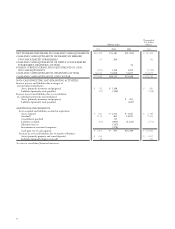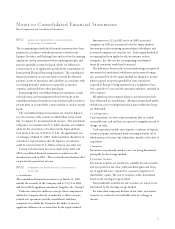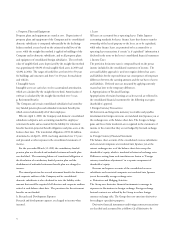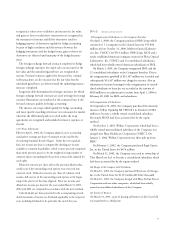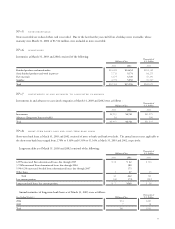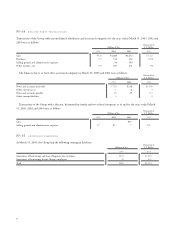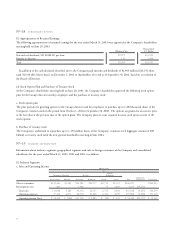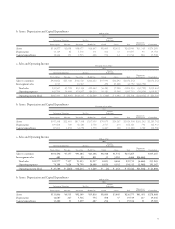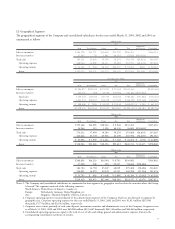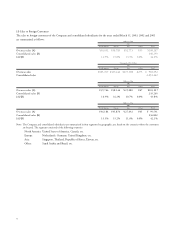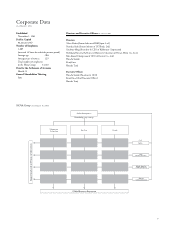Pentax 2003 Annual Report Download - page 49
Download and view the complete annual report
Please find page 49 of the 2003 Pentax annual report below. You can navigate through the pages in the report by either clicking on the pages listed below, or by using the keyword search tool below to find specific information within the annual report.
47
No»10 SHAREHOLDERS’ EQUITY
Japanese companies are subject to the Code to which certain
amendments became effective from October 1, 2001.
The Code was revised whereby common stock par value was
eliminated resulting in all shares being recorded with no par value
and at least 50% of the issue price of new shares is required to be
recorded as common stock and the remaining net proceeds as
additional paid-in capital. The Code permits Japanese companies,
upon approval of the Board of Directors, to issue shares to existing
shareholders without consideration as a stock split. Such issuance
of shares generally does not give rise to changes within the
shareholders’ accounts.
The revised Code also provides that an amount at least equal to
10% of the aggregate amount of cash dividends and certain other
appropriations of retained earnings associated with cash outlays
applicable to each period shall be appropriated as a legal reserve (a
component of retained earnings) until such reserve and additional
paid-in capital equals 25% of common stock. The amount of total
additional paid-in capital and legal reserve that exceeds 25% of the
common stock may be available for dividends by resolution of the
shareholders. In addition, the Code permits the transfer of a
portion of additional paid-in capital and legal reserve to the
common stock by resolution of the Board of Directors.
The revised Code eliminated restrictions on the repurchase and
use of treasury stock allowing Japanese companies to repurchase
treasury stock by a resolution of the shareholders at the general
shareholders meeting and dispose of such treasury stock by
resolution of the Board of Directors beginning April 1, 2002. The
repurchased amount of treasury stock cannot exceed the amount
available for future dividend plus amount of common stock,
additional paid-in capital or legal reserve to be reduced in the case
where such reduction was resolved at the general shareholders
meeting.
The amount of retained earnings available for dividends under
the Code was ¥142,630 million ($1,188,583 thousand) as of
March 31, 2003, based on the amount recorded in the Company’s
general books of account. In addition to the provision that
requires an appropriation for a legal reserve in connection with the
cash payment, the Code imposes certain limitations on the amount
of retained earnings available for dividends.
Dividends are approved by the shareholders at a meeting held
subsequent to the fiscal year to which the dividends are applicable.
Semiannual interim dividends may also be paid upon resolution of
the Board of Directors, subject to certain limitations imposed by
the Code.
On June 21, 2002, the Company’s shareholders approved a stock
option plan for the Group’s directors and key employees. Under the
plan, 936 thousand options were granted to them to purchase shares
of the Company’s common stock during the exercise period from
October 1, 2003 to September 30, 2007. The options were
granted at an exercise price of ¥7,670 ($64).
Assumptions used for the years ended March 31, 2003, 2002 and 2001 are set forth as follows:
2003 2002 2001
Discount rate 2.5% 3.5%
Expected rate of return on plan assets 5.5% 5.5% 5.5%
Amortization period of prior service cost 12 years 12 years 12 years
Recognition period of actuarial gain/loss 12 years 12 years 12 years
Amortization period of transitional obligation 15 years 15 years 15 years
Remaining balances of prior service cost, actuarial gain/loss and transitional obligation were charged to income when the contributory
funded pension plan was dissolved and unfunded retirement benefit plan was abolished for the year ended March 31, 2003.
Accrued retirement benefits for directors and corporate auditors of the Company and its consolidated domestic subsidiaries are
paid subject to approval of the shareholders in accordance with the Japanese Commercial Code (the “Code”). Accrued retirement
benefits recorded in the accompanying consolidated balance sheets at March 31, 2003 represents the accrued retirement benefits for
directors and corporate auditors and accrued retirement benefits at March 31, 2002, included amounts for directors and corporate
auditors in the amount of ¥254 million.





